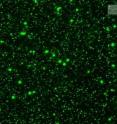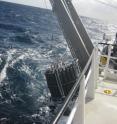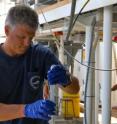Decade-long study reveals recurring patterns of viruses in the open ocean
Viruses fill the ocean and have a significant effect on ocean biology, specifically marine microbiology, according to a professor of biology at UC Santa Barbara and his collaborators. Craig A. Carlson, professor with UCSB's Department of Ecology, Evolution, and Marine Biology, is the senior author of a study of marine viruses published this week by the International Society for Microbial Ecology Journal, of the Nature Publishing Group.
The new findings, resulting from a decade of research, reveal striking recurring patterns of marine virioplankton dynamics in the open sea, which have implications regarding our understanding of cycling of nutrients in the world's oceans.
Marine viruses encompass enormous genetic diversity, affect biogeochemical cycling of elements, and partially control aspects of microbial production and diversity, according to the scientists. Despite their importance in the ocean, there has been a surprising lack of data describing virioplankton distributions over time and depth in open oceanic systems.
"Microbial interactions, between oceanic viruses and bacteria, take place on the nanometer scale but are extremely important in governing the flow of energy and the cycling of nutrients like carbon, nitrogen, and phosphorus on the ecosystem scale of the world's oceans," said Carlson. The scientists studied microbes in the water column of the Saragasso Sea, off of Bermuda, for a decade.
"Although we can't see them with our naked eye, marine microbes are the dominant life forms in our oceans," said Rachel J. Parsons, first author and a microbial oceanographer with the Bermuda Institute of Ocean Science. "They comprise 95 percent of the living biomass in the oceans -- more than all the krill, fish and whales put together. They grow at rates many times faster than larger animals. As a result of their sheer numbers, and the rates at which they grow, they are responsible for transforming and shaping the distribution of life's essential elements -- and they help control climate on our planet. Without marine microbes, life as we know it could not persist."
According to the scientists, there are approximately 10 million viruses in every drop of surface seawater, yet despite the high number of viruses very few are infectious agents to larger animals like fish, whales, or humans. That is because almost all of the marine viruses are "phages" -- viruses that specifically attack marine bacteria. Marine phages cannot carry out cellular metabolism and must therefore rely on the metabolic machinery of their bacterioplankton hosts to replicate. This warfare often kills the hosts, causing them to spill their internal nutrient content into the surrounding water.
In the new paper, the authors describe remarkably regular annual patterns of virioplankton abundance, tied to ocean physics and chemistry. These patterns in turn control the dynamics of the bacterioplankton hosts. The data suggest that a significant fraction of viruses in the upper photic, or light, zone of the subtropical oceanic gyres may be cyanophages -- viruses that infect photosynthetic bacterioplankton.
If true, the dominance of cyanophages in open ocean systems has significant biogeochemical implications. Viral-mediated breakdown of cyanobacteria could benefit phytoplankton through the release of macro- and micronutrients. Viral breakdown of host cells converts particulate material to suspended or dissolved materials such as amino acids and nucleic acids, effectively resulting in the retention of nitrogen, phosphorus, and iron within the surface water. These dissolved materials fuel microbial activity in an otherwise nutrient-poor open ocean system.
In this decade-long study, the scientists studied in unprecedented detail the temporal and vertical patterns of virioplankton abundance within the open ocean. Samples were collected throughout the upper 300 meters of the water column every month, beginning in the year 2000, at an open ocean hydrostation called the Bermuda Atlantic Time-series Study (BATS) site. The additional data collected as part of the BATS program provides oceanographic details regarding ocean physics, chemistry, and biology that are extremely valuable for interpreting the observed trends in marine phages.
"This high-resolution, decadal survey provides insight into the possible controls of virioplankton dynamics and the role they play in regulating biology and nutrient cycling in the open ocean," said Carlson. "The data provided by this study will now be utilized by ecosystem and biogeochemical modelers in an attempt to better understand how microbial processes affect the larger biogeochemical cycling in the ocean."
Other co-authors of the study are Mya Breitbart, of the University of South Florida, and Michael W. Lomas, of the Bermuda Institute of Ocean Science.
Source: University of California - Santa Barbara
Other sources
- Decade-long study reveals recurring patterns of viruses in the open oceanfrom Biology News NetThu, 11 Aug 2011, 21:00:19 UTC
- Decade-long study reveals recurring patterns of viruses in the open oceanfrom Science DailyThu, 11 Aug 2011, 18:30:23 UTC
- Decade-long study reveals recurring patterns of viruses in the open oceanfrom PhysorgThu, 11 Aug 2011, 17:30:26 UTC


